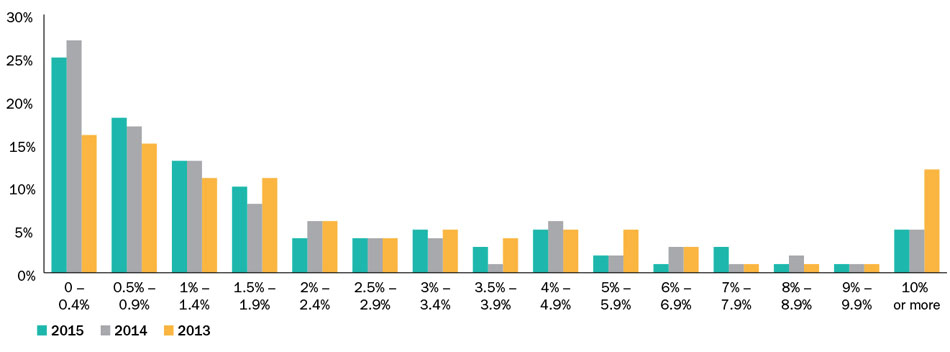Corporate Pension Risk Increases in 2015
After a year of decline, corporate pension risk is back on the rise, according to the Towers Watson’s pension risk index (PRI).
The measurement—designed to represent the increase in underfunding among pension plans for the next year—showed that Fortune 1000 pension plans saw their scores tick up slightly in 2015 to 1.3%. In a report accomanying the data, Towers Watson attributed this increase to lower interest rates and new mortality assumptions, which increased plan obligations.
The increase in risk would have been higher, the consultant continued, if it had not been offset by “moderate” equity returns, which increased the companies’ market capitalization and strengthened their overall financial positions at the end of 2014—along with an overall shift to more conservative asset strategies.
Although the median PRI score increased, nearly half of the corporate pensions actually improved their risk profiles over the year. According to Towers Watson, 49% of Fortune 1000 plans decreased their level of risk from 2014 to 2015, while 47% saw an increase in risk.
For those companies whose scores improved, Towers Watson cited a substantial shift in asset allocation as the driving factor, as well as a slight decline in median pension size relative to sponsors’ market capitalization. This fell from 17.2% at the beginning of 2014 to 16.3% at the beginning of 2015.
A drop in median allocations to equity by these pensions from 50% in 2014 to 44% in 2015 meant “plan funding was less vulnerable to being buffeted by adverse equity markets,” the report continued.
Instead, pensions that saw the most improvement in PRI scores allocated assets to long-duration bonds, which hedged the impact of interest rate movements on liabilities.
For companies that did worse, relative plan size grew from 10.8% of market capitalization at the beginning of 2014 to 12.6% at the beginning of 2015. These plans also suffered from retaining their asset allocation strategies: Median allocations to equity by this group dropped only slightly from 48% to 47%.
To de-risk their plans, Towers Watson recommended that companies with high-risk pensions shift assets from equity to debt and other less market-sensitive investments. Additionally, plan sponsors could reduce retiree and other inactive obligations by purchasing annuities.
“Where there is risk, there is also opportunity,” the report concluded. “Plan sponsors should consider where they stand on the spectrum.”
 Distribution of PRI scores among Fortune 1000 DB plan sponsors. Source: Towers Watson 2015 Pension Risk Index
Distribution of PRI scores among Fortune 1000 DB plan sponsors. Source: Towers Watson 2015 Pension Risk Index
